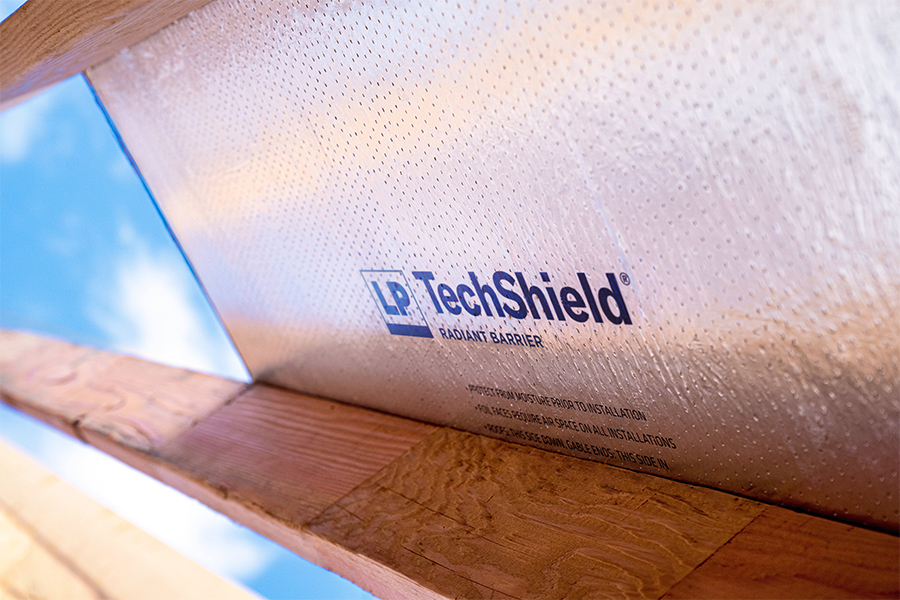Business Advice5 min
How Should Radiant Barrier Be Installed?
In any home, heat and moisture play a role during construction and long after. LP® TechShield® Radiant Barrier, the #1 radiant barrier sheathing in the industry, is equipped with VaporVents™ Technology that allows trapped moisture to escape during and after construction while the foil blocks up to 97% of radiant heat in roof panels from emitting into the attic.
Since LP TechShield panels have already been installed in over 2 million homes in the United States and continue to be a leader in radiant barrier sheathing, a refresh on how to install sheathing can help maximize the product’s performance and keep you from an installation error that can impact your warranty.
Let’s take a look at a list of quick tips to keep top-of-mind for radiant barrier sheathing installation.
Radiant Barrier Sheathing Installation Do’s and Don’ts
Do
Store panels in a clean, dry space off the ground
Install with the foil side down
Install with the long dimension across supports and with the panel continuous over two or more spans
Prior to roofing, cover LP TechShield Radiant Barrier sheathing as soon as it’s installed with roofing felt or shingle underlayment to protect against excessive moisture prior to roofing
Don’t
Expose foil side to the elements
Drop on corners or crush edges
Damage the foil surface
Find complete installation instructions here.

How To Install Radiant Barrier Sheathing Properly
Now that you have these crucial do’s and don’ts top-of-mind, let’s dive into more detailed installation instructions for how to install radiant barrier sheathing.
Step 1: Prepare Your Panels
One of the most common mistakes when it comes to radiant barrier sheathing installation is installing the panels with the incorrect side facing down. Radiant barrier sheathing panels have two sides: a foil surface and a skid-resistant surface.
LP TechShield panels should always be installed with the foil side down and the skid-resistant side facing up. Be sure to wear skid-resistant shoes during radiant barrier sheathing installation in a roof application.
Step 2: Space and Arrange Panels
Space all panel edges at a 1/8-inch minimum. Install with the long dimension across supports and with the panel continuous over two or more spans. End joints should meet over framing.
Step 3: Attach Panels to Framing
In the absence of project specifications, nail panels 6 inches on center along supported ends and edges and 12 inches on center at intermediate supports. Fasten panels 3/8-inch from panel edges. Use 8d common nails.

Step 4: Cover Roof Sheathing
Cover LP TechShield Radiant Barrier sheathing as soon as possible with roofing felt or shingle underlayment to protect against excessive moisture prior to roofing.
Once the sheathing is covered, your LP TechShield installation is complete!
Common Mistakes When Installing Radiant Barrier Sheathing
Installing the foil side up
Leaving the surface exposed to the elements
Not properly spacing the panel ends and edges
With these do’s, don’ts and watchouts on hand, you’re ready to start installation. Find detailed step-by-step installation instructions here.
Continue Reading
Resiliency Solutions
5 minIntroducing LP® SmartSide® ExpertFinish® Naturals Collection™: Nature-Inspired Beauty Meets Engineered Performance
We’re excited to introduce the LP® SmartSide® ExpertFinish® Naturals Collection™, a bold new addition to our trusted line of engineered wood siding and trim that delivers the warmth and beauty of nature with the advanced protection and performance builders and homeowners expect.
Labor Solutions
5 minChoosing the Right LP® Structural Solutions Product for Your Build
When it comes to building strong, reliable, and high-performing structures, the materials you choose matter. At LP Building Solutions, we understand that every project, whether it's a single-family home or a multifamily development, requires structural components that meet your needs for strength, durability, and efficiency.
Sustainability Solutions
5 minBuilding a More Sustainable Future with LP Building Solutions
In today's world, sustainability is no longer just a buzzword, it's a blueprint for responsible living and smarter building. As the construction industry seeks ways to reduce its environmental footprint, LP Building Solutions is focused on providing innovative building materials for eco-conscious builders to help reshape what it means to build sustainably
News & Stories3 min
History of Partnership with Gary Sinise Foundation
The LP Foundation is a proud partner of the Gary Sinise Foundation, which supports wounded veterans in several ways. You can learn more about the LP Foundation here.